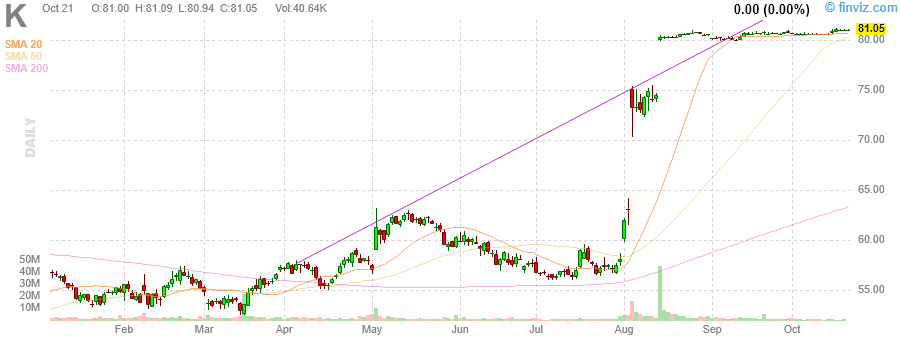
He's lonely and wants more people to look like him.
The big guy was last seen in "If You Want To Be Happy, Listen Up. Now! alternative title: The FT's Izabella Kaminska Is..." wherein Ms. K interviewed Robert Lustig, a pediatric endocrinologist at UCSF on neurotransmitters and the difference between happiness and pleasure and metabolic pathways and all kinds of stuff. And that's the hook for this quick post.
Going back to the introduction to March 7's M&A In European Food:
I'm not sure that consumer packaged goods is the area to be in, at least not in the U.S. and not based on names like Kellogg or General Mills.In May 25's "Nine of the World's Biggest Packaged Food Companies Have Launched Venture Capital Units" we looked at the charts for the two stocks mentioned in the March introduction:
For a quarter-century those manufacturers ratcheted prices as though they were tobacco companies but people find it easier to give up their Cheerios than their cigarettes.
The managements milked that approach for pretty much all it was worth so, as operating entities, they aren't all that attractive but someone will decide the only thing left to do is to asset strip or dividend recap the life out of the former cash cows.
Top o'the market to ya...
...And on to the charts of the two companies mentioned in that March 7 post:


If interested see also 2012's "Illusion of Choice: Consolidation in the Packaged Food Industry":
From Chart Porn:
This has been making the rounds lately. I find it as interesting to look at the minimalist design inherent in modern logos as the ownership concentrations.
(click to enlarge)
.You'll note our two examples top right. For a more in-depth look at the brands these companies own, Inverse published "Snack Choice Is an Illusion, Ten Brands Control Everything" on September 29 which took a 2017 look at the 2012 graphic:
Look on my brands ye Mighty, and despair!
Per the paradox of choice, the more options you’re presented with, the less happy you’ll be once you finally choose one. So if you’re paralyzed by indecision about which corporation to support with your snack dollars, fear not, because there are nowhere near as many options as you’d think.In 2014, Oxfam mapped out the properties of 10 different corporations, from Coca-Cola to Kellogg’s, to demonstrate just how insular the realm of processed food can be. The resulting infographic is sometimes shocking. For instance, it is faintly distressing but wholly fascinating to know that the same corporation, Mondelēz International, produces Dentyne and Velveeta.To know that 10 companies control most of the world’s bottled water, cheese snacks, frozen food, and cereal options is to experience a uniquely modern sense of existential dread. How can a consumer hope to make their money talk when spending is more equivalent to a scream into the void? Well, thankfully Nestle makes Hot Pockets.If you’re feeling masochistic, here’s a quick breakdown of who owns what.
Coca-Cola

MarsThe Coca-Cola breakdown doesn’t hold a ton of surprises. They stay in their lane and only produce other drinks, unlike those freaks over at PepsiCo. A little disappointing to see Odwalla under here but otherwise no earth-shattering information.

Hmmmm, Uncle Ben’s. Sure, all of these food items aren’t made with the same equipment or anything, but this is still a little bit suspect. Mars also has a very strong showing in the gum department. Good to know you’re not cheating on Doublemint when you chew Orbit....MUCH MORE
